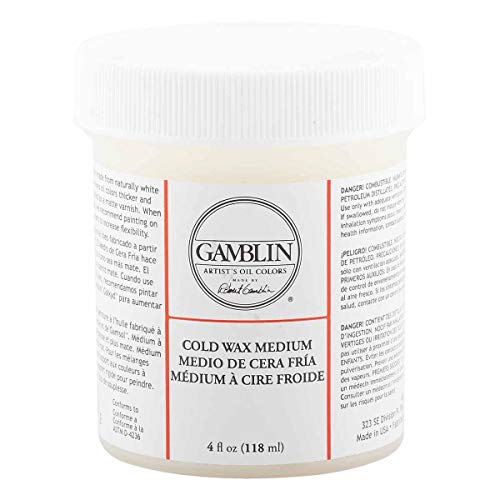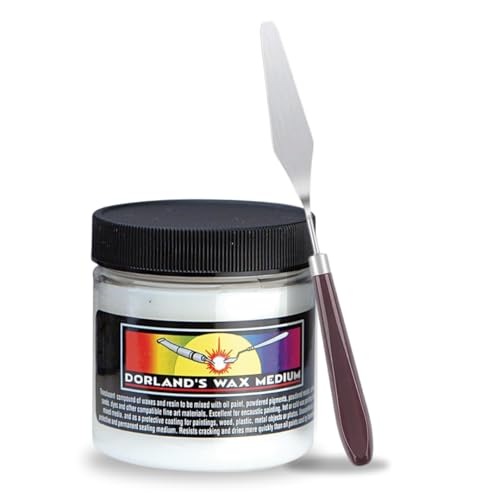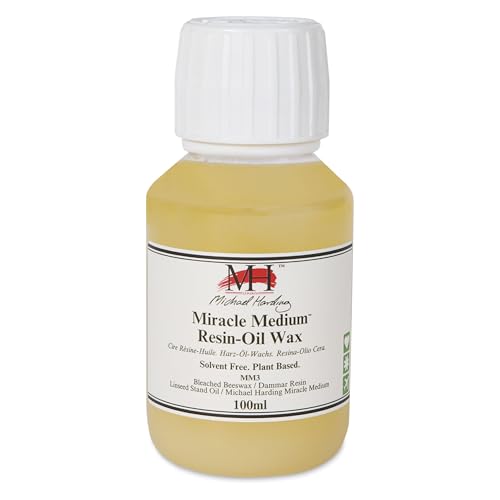When it comes to oil painting, the right cold wax medium can truly enhance your artistry. These mediums not only improve texture but also promote quicker drying times and vibrant color applications. You might be surprised by how each product can transform your work and inspire new techniques. Let’s explore ten of the best cold wax mediums available, so you can elevate your creations to a whole new level.
Gamblin Artist Colors Cold Wax Oil Painting Medium Clear 4oz jar
The Gamblin Artist Colors Cold Wax Oil Painting Medium in a 4oz jar is perfect for artists seeking to enhance their oil painting techniques with a matte finish and unique textures. This medium thickens your oil or alkyd paints, allowing you to build translucent layers effortlessly. You can create striking color fields without visible brush strokes using a palette knife, giving your artwork a distinctive flair. Plus, it’s non-toxic and tintable, making it versatile for various applications, including watercolor. Just remember, it’s best used indoors and clean up with mineral spirits to avoid any residue. Elevate your artistry today!
Best For: Artists looking to enhance their oil painting techniques with a versatile and non-toxic medium that provides a matte finish and unique textures.
Pros:
- Easy mixing with oil or alkyd paints for customizable consistency.
- Faster drying times, allowing for quicker layering and adjustments.
- Ideal for creating textured looks using palette knives, enhancing artistic expression.
Cons:
- Requires caution during application to prevent residue on surfaces.
- Limited waterproofing may affect longevity in certain applications.
- Indoor usage recommended, which may limit outdoor painting opportunities.
Cold Wax Medium Size: 16 oz
For artists seeking a versatile medium that enhances oil painting techniques, the 16 oz Gamblin Cold Wax Medium stands out. This soft paste, made from unbleached beeswax, alkyd resin, and odorless mineral spirits, allows for seamless mixing with oil paints. With a recommended ratio of 1/3 wax to 2/3 oil paint, it prevents cracking while adding texture and a matte finish. Its faster drying time enhances reworking but limits blending. Ideal for rigid supports, this medium has received high customer ratings, proving its quality and effectiveness. Elevate your artistry with this essential tool in your studio.
Best For: Artists looking for a versatile medium that enhances oil painting techniques while providing a buttery smooth texture.
Pros:
- High customer satisfaction with a rating of 4.7 out of 5 stars.
- Fast drying time allows for quick reworking of artwork.
- Adds texture and a matte finish, ideal for various oil painting techniques.
Cons:
- Some users find the 16 oz size small for the price.
- Not suitable for use on stretched canvas due to flexing risks.
- Limited blending capabilities with wet paint due to faster drying time.
Jacquard Dorlands Wax – 4 Ounce Pure Wax and Damar Resin
Artists seeking versatility in their medium will find Jacquard Dorlands Wax – 4 Ounce Pure Wax and Damar Resin an excellent choice. This cold wax medium serves as a sealant, varnish, and medium all in one, making it a favorite for sealing and finishing various artworks. It’s particularly popular for watercolor and gouache paintings. The durable waterproof finish enhances color depth and allows for glassless framing. You can choose a rough, matte effect or buff it for a high gloss. Plus, it won’t yellow over time, ensuring your artwork remains protected for ages.
Best For: Artists looking for a versatile medium that serves as a sealant, varnish, and finishing touch for various artworks.
Pros:
- Durable waterproof finish enhances color depth and protects artwork.
- Allows for glassless framing and display options.
- Malleable finish can be customized for matte or high gloss effects.
Cons:
- May require practice to achieve the desired finish.
- Not suitable for all types of media beyond recommended uses.
- Can be less effective in humid environments if not applied properly.
Jacquard Dorlands Wax Cold Wax Medium (4 fl oz)
Crafted for creative individuals seeking versatility, the Jacquard Dorlands Wax Cold Wax Medium (4 fl oz) is an exceptional choice for enhancing your oil painting projects. This medium blends seamlessly with oil paints, powdered pigments, and even colored sands, allowing for endless artistic possibilities. Whether you’re working in cold wax art, art journals, or need a protective layer for watercolor paintings, it’s perfect for your needs. Plus, it’s compatible with any varnish to finish your pieces beautifully. The included Moshify Palette Knife helps you mix and apply, making your creative process smooth and enjoyable. Elevate your artistry with this indispensable medium!
Best For: Artists looking for a versatile medium to enhance oil paintings, protect watercolors, and explore cold wax techniques.
Pros:
- Versatile Usage: Compatible with various art materials, including oil paints, pigments, and dyes.
- Protective Sealer: Effectively seals watercolor paintings against water and humidity.
- Includes Tool: Comes with a Moshify Palette Knife for easy mixing and application.
Cons:
- Limited Size: The 4 fl oz container may not be sufficient for larger projects.
- Cold Application Only: Not suitable for hot wax applications, which may limit some techniques.
- Potential Learning Curve: Artists new to cold wax may need time to experiment and master its use.
Gamblin Cold Wax Medium for Oil Painters (32 Fluid Ounce Can)
Gamblin Cold Wax Medium is an exceptional choice for oil painters seeking to enhance their work with unique textures and a matte finish. This 32 fluid ounce can contains a dense paste made from natural beeswax, Gamsol, and a touch of alkyd resin, allowing you to create stunning textural effects. It thickens your oil colors while ensuring sharp peaks of impasto, thanks to its “short” characteristic. Plus, it’s tintable and compatible with both oil and alkyd colors. With a perfect 5.0-star rating, it’s a favorite among artists. Enjoy the flexibility and creativity this medium brings to your artistry!
Best For: Oil painters who want to create textured artwork with a matte finish and enhance their oil colors.
Pros:
- Compatible with oil and alkyd colors, allowing for versatile application.
- Thickens paint and retains sharp peaks of impasto for dynamic textural effects.
- Tintable, enabling customization of colors and finishes.
Cons:
- The dense paste may require some practice to achieve desired textures.
- Limited to oil-based mediums, not suitable for acrylic or watercolor artists.
- Larger can size may be more than needed for beginners or casual painters.
Jacquard Dorlands Wax Medium for Oil Painting & Watercolor Sealing
If you’re looking for a versatile medium that enhances your oil paintings and seals watercolors, Jacquard Dorlands Wax Medium is an excellent choice. This 4 fl oz cold wax combines pure wax and damar resin, giving you a smooth, blendable consistency. It seals your artworks, protecting them from yellowing and cracking while preserving their vibrancy and texture. You can easily apply it with a brush, cloth, or even your fingers. Artists love its buttery texture and matte finish, making it suitable for both professionals and beginners. Plus, it’s made in the USA with high-quality ingredients for reliable results.
Best For: Artists seeking a versatile medium for enhancing oil paintings and sealing watercolors.
Pros:
- Smooth, blendable consistency that enhances artwork without compromising vibrancy.
- Easy application with various tools including brushes, cloths, or fingers.
- Positive user feedback highlighting its buttery texture and effectiveness in protecting art.
Cons:
- May require practice to master application techniques for optimal results.
- Limited to a 4 fl oz jar, which might not be sufficient for larger projects.
- Some users may find the matte finish less desirable for certain artistic styles.
Princeton Catalyst Tools for Texturizing and Moving Paint
For artists seeking innovative tools to enhance their oil painting techniques, Princeton Catalyst Tools stand out with their flexible, durable silicone design. These versatile tools, mounted on ergonomic wooden handles, fit comfortably in your hand, allowing for direct interaction with your work. They’re compatible with various mediums, including oils, acrylics, and even encaustics. Their heat and solvent resistance opens up endless creative possibilities. Cleanup is a breeze—just use mild soap and water, and dried paint peels off easily. With Princeton Catalyst Tools, you can elevate your artistry by texturizing and moving paint like never before.
Best For: Artists looking for innovative and versatile tools to enhance their painting techniques across various mediums.
Pros:
- Ergonomic design allows for comfortable handling and direct interaction with the artwork.
- Multi-media compatibility makes these tools suitable for a wide range of materials, including oils, acrylics, and encaustics.
- Easy to clean with mild soap and water, making maintenance hassle-free.
Cons:
- Limited to specific artistic styles; may not be ideal for traditional brush techniques.
- Silicone flexibility might not provide the same control as rigid tools for some artists.
- Price point may be higher compared to basic painting tools, potentially deterring budget-conscious buyers.
Williamsburg Artist Oil Colors by GOLDEN, Wax Medium, 16 fl oz. can
Williamsburg Artist Oil Colors by GOLDEN’s Wax Medium is an excellent choice for artists seeking to enhance their oil paintings with a buttery texture and increased transparency. This 16 fl oz can contains pure beeswax, damar resin, and refined linseed oil, ensuring a satin sheen while being free from paraffins and microcrystallines. You can thicken your paint and achieve that desirable, short texture, but remember to use it in moderation. With an average rating of 4.3 stars, artists appreciate its quality, though some have noted issues with wax chunks. Overall, it’s a reliable option to elevate your artistry.
Best For: Artists looking to enhance their oil paintings with a buttery texture and increased transparency.
Pros:
- Enhances paint texture and transparency, offering a satin sheen.
- Made from high-quality, natural ingredients, ensuring a professional-grade finish.
- Handmade in the USA with over 40 years of experience in the art supply industry.
Cons:
- Some users report issues with wax chunks affecting usability.
- Requires careful moderation in usage to achieve desired effects.
- Average customer rating indicates mixed feedback regarding performance.
Wax Medium Capacity: 8 Oz
The 8 Oz capacity of the Cold Wax Medium makes it an ideal choice for artists who appreciate both versatility and convenience in their oil painting materials. Packaged in a compact can measuring 3.38 x 3.38 x 4 inches, it’s lightweight at just 1.11 lbs, making it easy to transport. This medium combines pure beeswax, damar resin, and refined linseed oil, ensuring a quality product free from parafins. You can use it for glazing and impasto techniques, enhancing your artwork’s texture and depth. With a 4.0-star rating, it’s a trusted option for elevating your artistry.
Best For: Artists seeking a versatile and high-quality medium for oil painting techniques like glazing and impasto.
Pros:
- Made from pure beeswax, damar resin, and refined linseed oil, ensuring a natural product free from parafins.
- Compact and lightweight design makes it easy to transport and store.
- Suitable for enhancing texture and depth in artwork, allowing for creative versatility.
Cons:
- Limited customer reviews may not provide a comprehensive view of user experiences.
- Best Sellers Rank indicates it may not be as popular as other art mediums.
- The 8 Oz capacity may not be sufficient for larger projects or frequent use.
Michael Harding Miracle Medium Resin-Oil Wax, 100ml
Artists seeking to elevate their oil painting techniques will find Michael Harding Miracle Medium Resin-Oil Wax, 100ml, an exceptional choice. This versatile medium blends effortlessly with oil paints, allowing you to create stunning textures and surface effects. Made from natural ingredients like pure bleached beeswax, dammar resin, and linseed stand oil, it offers a beautiful satin sheen and gentle impasto. You can modify the paint’s body for diverse expressions, facilitating unique handling and textural effects. Whether sculpting or blending, this medium enriches your artistry and opens up new possibilities in your work. Embrace its versatility for transformative results!
Best For: Artists looking to enhance their oil painting techniques with a versatile medium for texture and surface effects.
Pros:
- Blends seamlessly with oil paints, offering diverse artistic expressions.
- Made from natural ingredients, ensuring a high-quality and safe product.
- Produces a beautiful satin finish and gentle impasto for enhanced visual appeal.
Cons:
- Limited to oil paints, which may not suit artists working with other mediums.
- Can be more expensive than standard oil painting additives.
- Requires experimentation to fully master its handling and effects.
Factors to Consider When Choosing Cold Wax Mediums for Oil Painting
When choosing a cold wax medium for oil painting, you should consider several key factors. Think about the composition and ingredients, as these can affect the medium’s texture and consistency. Also, pay attention to drying times and how well the medium works with your chosen paints and application techniques.
Composition and Ingredients
Choosing the right cold wax medium for oil painting involves considering its composition and ingredients, as these factors directly influence your artwork’s texture, durability, and color vibrancy. Most cold wax mediums combine natural beeswax, alkyd resin, and odorless mineral spirits, enhancing both texture and drying times. If you’re looking for a durable finish, opt for formulations without oil, which can also serve as a varnish over dry paintings. Stick to recommended mixing ratios, ideally no more than 1/3 wax to 2/3 oil paint, to avoid cracking. Pay attention to ingredient quality—unbleached beeswax and damar resin can greatly impact color retention and resistance to yellowing. Finally, some mediums allow tinting for personalized color adjustments.
Texture and Consistency
The texture and consistency of cold wax mediums play a significant role in how your oil paints behave on the canvas. These mediums can range from soft paste to dense, thick pastes, affecting their mixability and application. If you prefer impasto techniques, a thicker medium with more beeswax creates a buttery smooth texture that’s perfect for achieving bold peaks and rich surfaces. Conversely, softer mediums allow for smoother brushwork. Additionally, cold wax mediums can enhance your artwork’s depth and dimension, as they retain sharp peaks when mixed with oil colors. Keep in mind that a medium’s consistency also influences its application method, so choose wisely based on your desired techniques and effects.
Drying Time Considerations
While cold wax mediums can greatly enhance your painting experience, understanding their drying time is essential for effective use. These mediums typically speed up drying times for oil paints, letting you rework your pieces more quickly than traditional oils. The solvent content in cold wax accelerates drying, making it ideal if you prefer faster results. However, different formulations can yield varying drying times; for example, those mixed with alkyd resins tend to dry faster. Keep in mind that while cold wax improves drying speed, it can limit your blending time, impacting your technique. Ultimately, always adhere to recommended mixing ratios, as exceeding these can lead to cracking and longer drying times in your artwork.
Application Techniques
Experimenting with application techniques can elevate your experience when using cold wax mediums in oil painting. Mixing cold wax with oil paints creates a buttery smooth texture, allowing for easy manipulation on the canvas. Remember to stick to a recommended ratio of no more than 1/3 wax to 2/3 oil paint to maintain flexibility and avoid cracking. Since cold wax dries faster, you can rework layers quickly, but be cautious as this may limit blending of wet paints. Use palette knives to create textured effects and achieve a matte finish free from brush strokes. This approach not only enhances the vibrancy and richness of your colors but also adds a unique visual quality to your artwork.
Compatibility With Paints
Choosing the right cold wax medium involves understanding how it interacts with various paints. Typically, these mediums work well with oil and alkyd paints, enabling you to modify texture and finish for your artwork. It’s essential to stick to a mixing ratio of no more than 1/3 wax to 2/3 oil paint to avoid cracking and guarantee integrity. Cold wax enhances the buttery texture of oil paints, allowing for smooth applications and impasto effects. Keep in mind that some mediums may speed up drying times due to their solvent-based nature, which can affect blending when wet. Additionally, certain cold wax formulas mix well with fine art materials like powdered pigments, offering you even more creative versatility.
Finish Type Options
When selecting a cold wax medium for your oil painting, the type of finish it provides can considerably impact your artwork’s overall look. Cold wax mediums usually offer a matte finish that enhances texture and depth without the glare of traditional varnishes. If you prefer a bit of shine, some mediums allow for a satin sheen, which can accentuate color vibrancy and add richness. By adjusting the ratio of cold wax to oil paint, you can manipulate the finish—more wax yields a thicker, matte texture. Additionally, mixing cold wax with other mediums can further modify the finish characteristics, giving you the versatility to create unique artistic effects that suit your vision.
Packaging and Volume
Selecting the right cold wax medium involves more than just the finish it offers; packaging and volume play significant roles in your choice. Cold wax mediums come in sizes ranging from 4 oz jars to 32 oz cans, catering to different needs. If you frequently use the medium, larger containers can provide better value. Consider how the packaging design affects usability and storage; jars allow easy access, while cans are suitable for bulk use. Keep in mind the weight differences too—while a 4 oz jar is lightweight, a 32 oz can is heavier, impacting shipping. Always relate the volume to your project scope, as larger works will demand more medium compared to smaller, detailed pieces.









